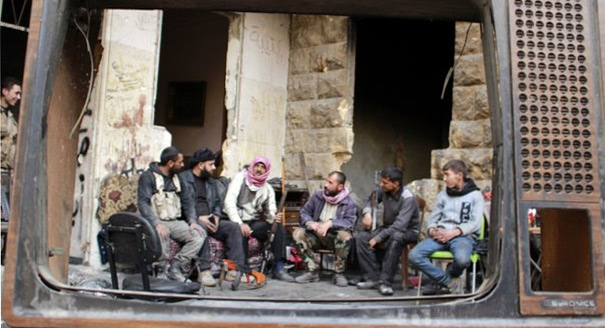Yesterday, I wrote about the November 6 statement declaring the creation of “the Greater Damascus Operations Room,” and promised that I would have another look at the list of participants (which is repeated at the end of this post, for easy reference). Because, regardless of who is part of the alliance, an equally important question is: who is not involved?
Three big groups come to mind.
Isolating the Islam Army?
The most obvious omission, to anyone that follows Syrian rebel politics, is the Douma-based Islam Army of Mohammed Zahran Alloush. This group, formerly known as the Islam Brigade, has recently raised its profile with the help of private Gulf sponsors and, allegedly, support from the Saudi government. It is now one of the largest and best-known fighting formations in Syria and certainly one of the largest groups in the Damascus region. But Zahran Alloush’s rise to stardom has not been without controversy and many factions took offense at the suggestion that the path to rebel unity is for everyone else to join the Army of Islam. As previously detailed on this blog, the formation of the Army of Islam in late September was immediately followed by a backlash among other Islamist factions in Damascus.
Now, when a virtual who’s who of the Damascus Islamist scene comes together to pool their resources, the Islam Army is left out. It can’t be a coincidence, but what does it mean?
Checking the list again, we see that some factions that have complained about Alloush’s dominance are involved with the Greater Damascus Operations Room, but the bulk of feuding brigades and councils in his hometown of Douma were not included; neither the Islam Army, nor its chief local rivals, like the Douma Martyrs Brigade.
So, it would seem that either the Greater Damascus Operations Room is actively seeking to isolate Alloush and push back against the ambitions of the Army of Islam, or, simply to maintain a prudent distance in order to avoid contagion from the disputes in Douma. Perhaps we’ll find out soon enough.
What Happened to the Jihadis?
There are two other interesting omissions: Neither of the global-jihadi factions linked to al-Qaeda is mentioned in the statement. The dissident Iraqi-Syrian Qaida wing, called the Islamic State of Iraq and al-Sham, is so far quite marginal around the capital, but Jabhat al-Nusra has a very active presence in some regions of the Rif Dimashq.
In fact, when studying the membership lists of the local operations rooms, an interesting discrepancy becomes clear. Several of these coalitions do in fact include the global-jihadi factions. For example, Jabhat al-Nusra is a charter member of the Jund al-Malahem alliance (#1 on the list below) and it is also part of the One Flag Alliance (#8) and the Islamic League (#6), the latter of with which also seems to include the Islamic State of Iraq and al-Sham.
Still, their names are mysteriously missing from the November 6. There seem to have been no announcements of them leaving and no recent reports of splits in these operations rooms. It therefore seems likely that their involvement is deliberately obscured, to avoid tainting the Greater Damascus Operations Room with any form of al-Qaida association.
This, in turn, probably reflects the nature of the funding for the project. Money is probably coming from above-the-table sources and it is likely to be supported by one or more Gulf governments; presumably related to Saudi Arabia’s drive to reorganize the Syrian insurgency. These sponsors are of course anxious not to be seen as enablers of terrorism, by their American ally or the media, and so, the Qaeda-linked factions in the operations rooms have been quietly scrubbed from the public statement of November 6. But are they also isolated from the operations rooms on the ground?
The Greater Damascus Operations Room
This is a list of the participating operations rooms and their list of members, as declared in the statement of November 6, 2013, with their approximate locations added in parenthesis.
- The Jund al-Malahem Operations Room in East Ghouta: Islamic Ahrar al-Sham Movement, Shabab el-Hoda Battalions, al-Habib al-Mustafa Brigades, Eissa bin Maryam Battalion. (Eastern/South-Eastern suburbs)
- The Jobar Operations Room: Shabab el-Hoda Battalions, al-Habib al-Mustafa Brigades. (East Damascus)
- The Mleha Operations Room: Shabab el-Hoda Battalions, al-Habib al-Mustafa Brigades. (Mleha, South-East suburbs)
- The Amjad al-Islam Operations Room in Erbin: The Amjad al-Islam Gathering. (East Damascus)
- The Harasta Operations Room: Der’ al-Asima Brigade, Shabab el-Houda Battalions, al-Habib al-Mustafa Brigades, Amjad al-Islam Gathering. (North-East suburbs)
- The Islamic League Operations Room in South Damascus: Sahaba Battalions and Brigades, Aknaf Beit al-Maqdes Brigade, Islamic Ahrar al-Sham Movement, Shabab al-Hoda Brigade, Single Umma Brigade, Sham al-Rasoul Brigade. (Yarmouk Camp/al-Hajar al-Aswad, south Damascus)
- The Daraya and Moadamiya Operations Room: Sahaba Battalions and Brigades. (Daraya/Moadamiya, west of Damascus)
- The One Flag Alliance Operations Room in Western Ghouta: Sahaba Battalions and Brigades, Tawhid al-Asima Brigade, Islamic Ahrar al-Sham Movement, Aknaf Beit al-Maqdes Brigade, Fursan al-Sunna Battalion. (Western countryside)
- The Zabadani Operations Room: Islamic Ahrar al-Sham Movement. (North-West of Damascus, Lebanon border)






